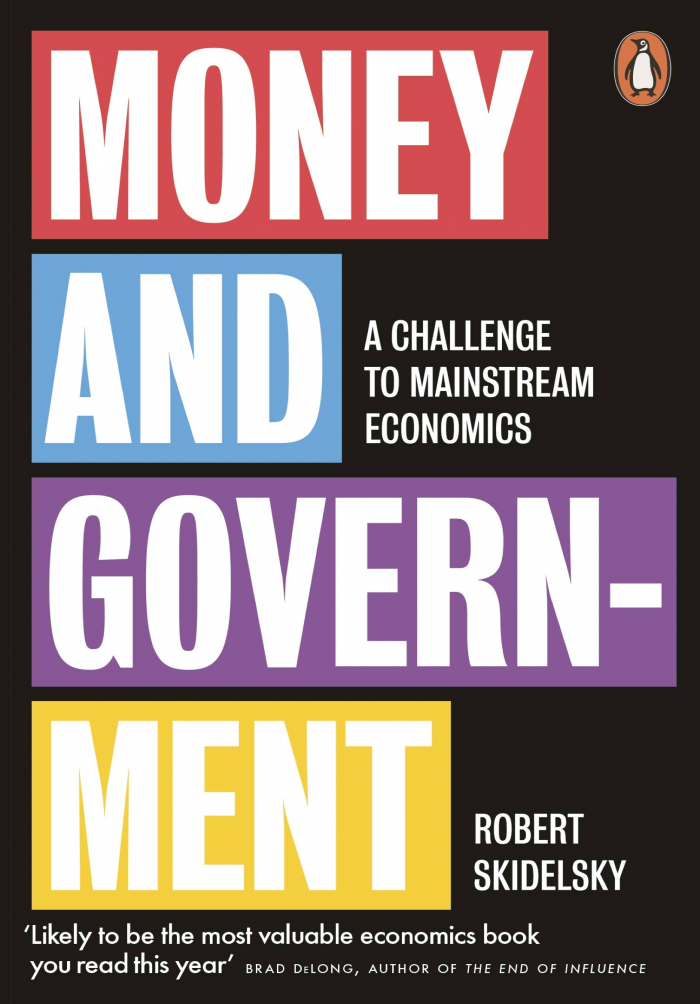
This is an account of the state of macroeconomics by one of our most eminent professors. It offers a potted history of economic thought, with particular emphases on the roles played by money and the state, and on the Keynesian revolution and monetarist/new classical counter-revolution. A contemporary focus is provided by the Global Financial Crisis and its aftermath. The book concludes with a manifesto for “a new macroeconomics”. Skidelsky is Keynes’ biographer of course, and the book is strongly partisan.
I enjoyed much of it, which is readable and accessible. The linking of earlier monetary ideas to the crisis of 2008 is effective, and there is a very good account of the ways in which Quantitative Easing may be thought to have worked (pp258-279). I almost cheered out loud when, apropos the current academic and central banking obsession with models, he suggests “One does not need to understand how the whole economy works to explain how all the individual parts work” (p387).
Throughout, he stresses the endogeneity of modern money – how it is effectively created on demand by the banking system, something the Bank of England has only felt able to acknowledge clearly in the last decade or so (though with that in mind, he perhaps devotes too much space to the quantity “theory” of money). The point being, of course, that a demand-driven money supply cannot easily play the causative role often attributed to it.
He is also good at deflating the conceits of central banking, noting that the inflation-targeting regime may have presided over disinflation, but did not necessarily cause it. He suggests that the emergence of the China price may have had something to do with it – just as OPEC had something to do with the initial surge.
However, I found the book frustrating too. His “new” macroeconomics is not really radical. He accepts unquestioningly the established tendency to tell the macro story from the expenditure side. There have been varying views as to how interest-sensitive investment and the demand for money might be, and he covers them carefully, but doesn’t ask whether they offer much epistemological traction. For this reviewer, that expenditure fixation is one of the reasons why macroeconomists in both main camps have had little useful to say.
It was also a little unusual to be reading so much about the fiscal multiplier in 2019. Skidelsky seems not to realise that the reason some people resist the notion may not be an ideological one, but simply a wariness of the conventional exposition.
His normative position leads him to accept some ideas too easily. For example, he seems to have bought the “secular stagnation” story as unthinkingly as a credit investor bought their CDO or CDS in 2008. He shows little interest in how reliable our data may be – whether he is discussing national accounts or global inequality – or in US and UK unemployment seemingly being close to half-century lows. He sees securitization as a recent development, and as leading to leverage. His description of the Lucas critique is unusual.
He is as partisan in support of government and fiscal activism as are the new classical theorists in support of the minimal state and monetary rectitude, and I found myself wishing a plague on both (badly-built) houses.
He is surely right, for example, to remind us of Mazzucato’s point that the public sector can be entrepreneurial. But in asserting that inflation could have been brought down at a lower cost if fiscal policy had been more active, he forgets perhaps how grim things were in the 1970s, and how fragile the social contract had become. The government’s budget constraint is indeed much looser than an individual’s, and the main driver of borrowing costs is usually the economy, not the budget deficit; but there are limits to fiscal potency (just as there are with money printing), and it felt as if we were close to them. Ex post, fiscal policy could have been looser; ex ante, the Keynesian establishment had no credibility left.
As noted, the routine focus on expenditures means that Skidelsky spends little time on what we make and sell, or on how profitably we do it. But coal and price-sensitive manufacturing were not the places to be in 1979. The surest way to revisit the romance of an extractive and low value manufacturing-led economy is for us to become collectively poorer and unprofitable.
Finally, I also suspect that Skidelsky – like many others – attributes too much to the global financial crisis. It was shocking and shameful, but market-oriented economies were always capable of doing what they did in 2008. Who didn’t know that? Forecasting failure need not signal heuristic failure. My guess is that economists try too hard, in search of an elusive “data generation process” or non-existent “General Theory”. We certainly learned in 2008 that we need better bankers, regulators and data, but is there anything more profound to be learned?
In summary, Professor Skidelsky believes that the current emphasis on monetary policy, inflation targeting and central bank independence is misplaced, and that financial services are largely fraudulent. He is in favour of greater equality and more active fiscal policy. In his account, new classical economists and monetarists are deceitful, while Keynesians make mistakes.
I share some of his value judgements and his diagnosis of central banking hubris, but I do not agree that “In reality, the only deficits the deficit-hawks really mind about are deficits incurred to protect the poor.” (p245) Some hawks may seek as civilised a society as the rest of us, but disagree over how best to deliver it.
Perhaps the problem with macroeconomics is its system-building pretention and pointless publication race, as much as its practitioners’ ideologies. Skidelsky says “ideas are produced in non-profitmaking institutions” (p13), but when did economics faculties last produce many of those?
Available at Timbooktoo tel 4494345





